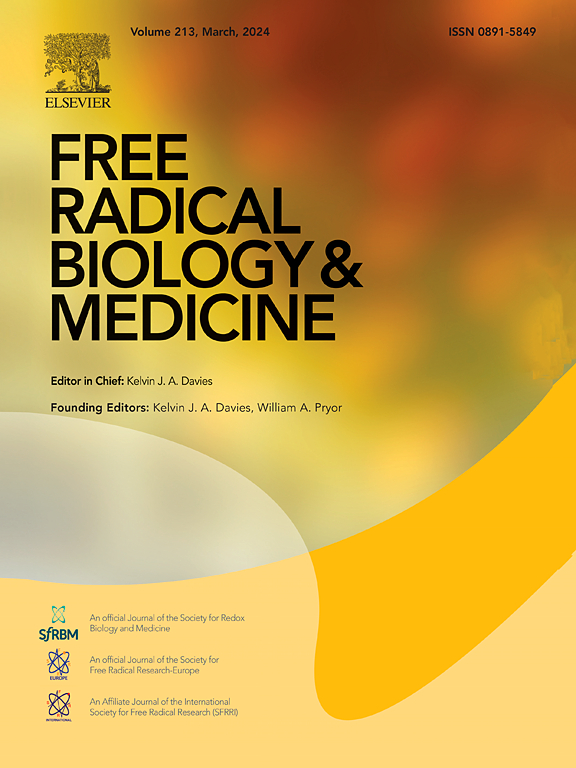Fut8调节的Unc5b超聚焦减少巨噬细胞迁移,并通过铁下沉途径加速动脉粥样硬化的发展
IF 7.1
2区 生物学
Q1 BIOCHEMISTRY & MOLECULAR BIOLOGY
引用次数: 0
摘要
动脉壁上泡沫细胞的积聚是动脉粥样硬化的一个显著特征。促进泡沫细胞从斑块中迁移可能是减缓疾病进展的关键策略。最近的研究表明,岩藻糖基转移酶8(Fut8)通过修饰Unc5b膜受体,阻碍巨噬细胞从内膜迁移,从而影响动脉粥样硬化的发展。本研究利用载脂蛋白E-/-小鼠和泡沫细胞模型,采用Western印迹、线粒体功能测试、伤口愈合实验和免疫荧光染色等技术,研究了Fut8和Unc5b在泡沫细胞迁移中的作用。研究结果表明,Fut8 的上调会增加 P53 的表达,降低 SLC7A11 和 GPX4 的水平,从而导致细胞内 GSH 和 Fe2+ 浓度的改变、线粒体功能受损以及迁移能力降低,所有这些都会促进动脉粥样硬化。这些机制与铁蛋白沉积症密切相关。N-乙酰半胱氨酸(NAC)和丁硫亚胺(BSO)的干预表明,NAC 可减轻氧化低密度脂蛋白(ox-LDL)诱导的氧化应激和迁移抑制。此外,抑制铁蛋白沉积可减缓载脂蛋白E-/-小鼠动脉粥样硬化的进展。总之,这些结果突出表明 Fut8 通过 P53/SLC7A11 介导的泡沫细胞铁嗜酸酶的增强加剧了动脉粥样硬化,为动脉粥样硬化的病理生理学提供了一个新的视角。本文章由计算机程序翻译,如有差异,请以英文原文为准。

Fut8 regulated Unc5b hyperfucosylation reduces macrophage emigration and accelerates atherosclerosis development via the ferroptosis pathway
The accumulation of foam cells in the arterial walls is a defining characteristic of atherosclerosis. Enhancing their migration from plaques may represent a key strategy for slowing disease progression. Recent studies suggest that fucosyltransferase 8 (Fut8) impairs macrophage migration from the intima by modifying the Unc5b membrane receptor, thereby influencing the development of atherosclerosis. This study investigated the roles of Fut8 and Unc5b in foam cell migration using ApoE−/− mouse and foam cell models, employing techniques such as western blotting, mitochondrial function assays, wound healing experiments, and immunofluorescence staining. The findings indicate that Fut8 upregulation increases P53 expression and reduces SLC7A11 and GPX4 levels, leading to altered intracellular concentrations of GSH and Fe2+, impaired mitochondrial function, and reduced migration capacity, all of which promote atherosclerosis. These mechanisms are closely associated with ferroptosis. Intervention with N-acetylcysteine (NAC) and buthionine sulfoximine (BSO) demonstrated that NAC mitigates oxidative stress and migration inhibition, induced by oxidized low-density lipoprotein (ox-LDL). Additionally, inhibiting ferroptosis slowed the progression of atherosclerosis in ApoE−/− mice. Together, these results highlight that Fut8 exacerbates atherosclerosis through a P53/SLC7A11-mediated enhancement of ferroptosis in foam cells, offering a novel perspective on the pathophysiology of atherosclerosis.
求助全文
通过发布文献求助,成功后即可免费获取论文全文。
去求助
来源期刊

Free Radical Biology and Medicine
医学-内分泌学与代谢
CiteScore
14.00
自引率
4.10%
发文量
850
审稿时长
22 days
期刊介绍:
Free Radical Biology and Medicine is a leading journal in the field of redox biology, which is the study of the role of reactive oxygen species (ROS) and other oxidizing agents in biological systems. The journal serves as a premier forum for publishing innovative and groundbreaking research that explores the redox biology of health and disease, covering a wide range of topics and disciplines. Free Radical Biology and Medicine also commissions Special Issues that highlight recent advances in both basic and clinical research, with a particular emphasis on the mechanisms underlying altered metabolism and redox signaling. These Special Issues aim to provide a focused platform for the latest research in the field, fostering collaboration and knowledge exchange among researchers and clinicians.
 求助内容:
求助内容: 应助结果提醒方式:
应助结果提醒方式:


